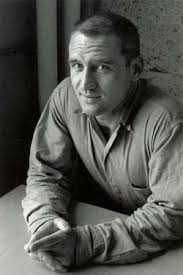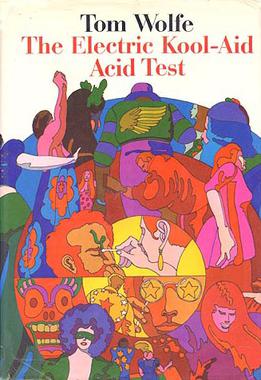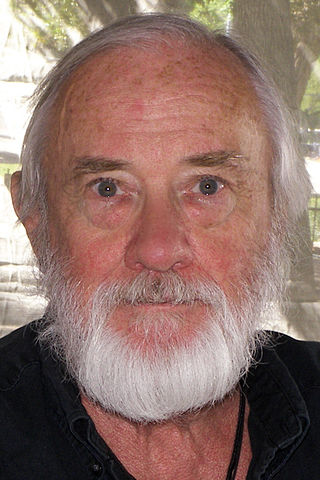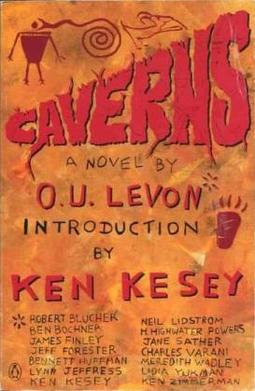
Ken Elton Kesey was an American novelist, essayist and countercultural figure. He considered himself a link between the Beat Generation of the 1950s and the hippies of the 1960s.

Neal Leon Cassady was a major figure of the Beat Generation of the 1950s and the psychedelic and counterculture movements of the 1960s.

Larry Jeff McMurtry was an American novelist, essayist, and screenwriter whose work was predominantly set in either the Old West or contemporary Texas. His novels included Horseman, Pass By (1962), The Last Picture Show (1966), and Terms of Endearment (1975), which were adapted into films. Films adapted from McMurtry's works earned 34 Oscar nominations. He was also a prominent book collector and bookseller.

The Electric Kool-Aid Acid Test is a 1968 nonfiction book by Tom Wolfe written in the New Journalism literary style. By 1970, this style began to be referred to as Gonzo Journalism, a term coined for the work of Hunter S. Thompson. The book presents a firsthand account of the experiences of Ken Kesey and a group of psychedelic enthusiasts, known as the Merry Pranksters, who traveled across the United States in a colorfully-painted school bus they called Furthur. Kesey and the Pranksters became famous for their use of psychedelic drugs to achieve expansion of their consciousness. The book chronicles the Acid Tests and encounters with notable figures of the time, and describes Kesey's exile to Mexico and his arrests.
The Merry Pranksters were followers of American author Ken Kesey. Kesey and the Merry Pranksters lived communally at Kesey's homes in California and Oregon, and are noted for the sociological significance of a lengthy road trip they took in the summer of 1964, traveling across the United States in a psychedelic painted school bus called Furthur, organizing parties, and giving out LSD. During this time they met many of the guiding lights of the 1960s cultural movement and presaged what are commonly thought of as hippies with odd behavior, tie-dyed and red, white, and blue clothing, and renunciation of normal society, which they dubbed The Establishment. Tom Wolfe chronicled their early escapades in his 1968 book The Electric Kool-Aid Acid Test, and documents a 1966 trip on Furthur from Mexico through Houston, stopping to visit Kesey's friend the novelist Larry McMurtry. Kesey was in flight from a drug charge at the time.

Furthur is a 1939 International Harvester school bus purchased by author Ken Kesey in 1964 to carry his "Merry Band of Pranksters" cross-country, filming their counterculture adventures as they went. The bus featured prominently in Tom Wolfe's 1968 book The Electric Kool-Aid Acid Test but, due to the chaos of the trip and editing difficulties, footage of the journey was not released as a film until the 2011 documentary Magic Trip.

Robert Anthony Stone was an American novelist, journalist, and college professor.

Jenny Diski FRSL was an English writer. She had a troubled childhood, but was taken in and mentored by the novelist Doris Lessing; she lived in Lessing's house for four years. Diski was educated at University College London, and worked as a teacher during the 1970s and early 1980s.
Carolyn Elizabeth Garcia, also known as "Mountain Girl", is an American Merry Prankster and the former wife of Jerry Garcia, the lead vocalist and guitar player with the band Grateful Dead.
Ken Babbs is a famous Merry Prankster who became one of the psychedelic leaders of the 1960s. He along with best friend and Prankster leader, Ken Kesey, wrote the book Last Go Round. Babbs is best known for his participation in the Acid Tests and on the bus Furthur.

Dog Soldiers is a novel by Robert Stone, published by Houghton Mifflin in 1974. The story features American journalist John Converse, a Vietnam correspondent during the war, Merchant Marine sailor Ray Hicks, Converse's wife Marge, and their involvement in a heroin deal gone bad. It shared the 1975 U.S. National Book Award for Fiction with The Hair of Harold Roux by Thomas Williams. Dog Soldiers was named by Time magazine one of the 100 best English-language novels, 1923 to 2005.

Who'll Stop the Rain is a 1978 American crime war film directed by Karel Reisz and starring Nick Nolte, Tuesday Weld, Michael Moriarty, and Anthony Zerbe. It was released by United Artists and produced by Herb Jaffe and Gabriel Katzka with Sheldon Schrager and Roger Spottiswoode as executive producers. The screenplay was by Judith Rascoe and Robert Stone, based on Stone's novel Dog Soldiers (1974), the music score by Laurence Rosenthal, and the cinematography by Richard H. Kline. The movie was entered in the 1978 Cannes Film Festival.

Sometimes a Great Notion is the second novel by American author Ken Kesey, published in 1964. While One Flew Over the Cuckoo's Nest (1962) is more famous, many critics consider Sometimes a Great Notion Kesey's magnum opus. The story involves an Oregon family of gyppo loggers who cut trees for a local mill in opposition to unionized workers who are on strike.

The Acid Tests were a series of parties held by author Ken Kesey primarily in the San Francisco Bay Area during the mid-1960s, centered on the use of and advocacy for the psychedelic drug LSD, commonly known as "acid". LSD was not made illegal in California until October 6, 1966.

Caverns is a 1989 novel written collaboratively as an experiment by Ken Kesey and a creative writing class that he taught at the University of Oregon. The cover of the book says it was written by O.U. Levon—the name of this supposed author, spelled backwards, is "novel U.O.". The full list of authors is: Robert Blucher, Ben Bochner, James Finley, Jeff Forester, Bennett Huffman, Lynn Jeffress, Ken Kesey, Neil Lidstrom, H. Highwater Powers, Jane Sather, Charles Varani, Meredith Wadley, Lidia Yukman and Ken Zimmerman.
Sterling Lord was an American literary agent, editor, and author. His clients included Jack Kerouac, Ken Kesey, Howard Fast, Jimmy Breslin, and Doris Kearns Goodwin.
Lee Quarnstrom was an American journalist, executive editor of Larry Flynt’s Hustler Magazine, and a Beatnik. He was a core member of the Merry Band of Pranksters, a group loosely led by novelist Ken Kesey.

Lidia Yuknavitch is an American writer, teacher and editor based in Oregon. She is the author of the memoir The Chronology of Water, and the novels The Small Backs of Children,Dora: A Headcase, and The Book of Joan. She is also known for her TED talk "The Beauty of Being a Misfit", which has been viewed over 3.2 million times, and her follow-up book The Misfit's Manifesto.

Tokyo Junkie: 60 Years of Bright Lights and Back Alleys... and Baseball is a 2021 memoir by Robert Whiting, discussing his experiences in Tokyo.













